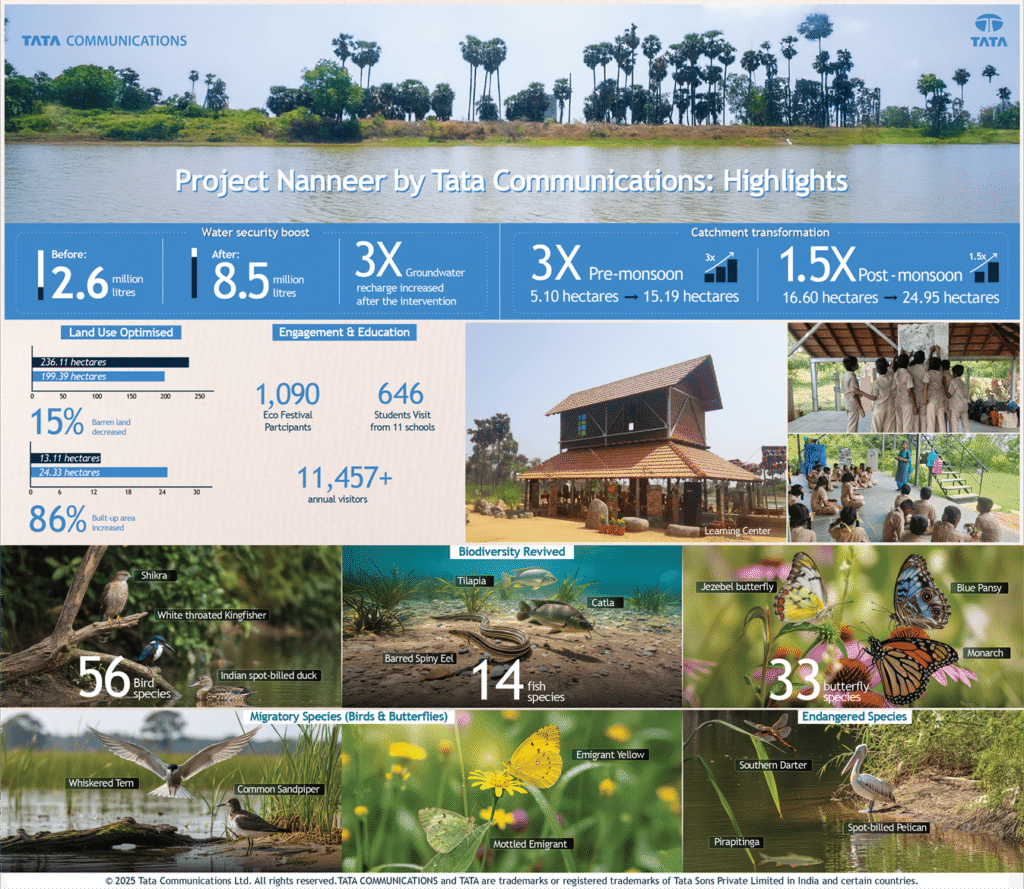CHENNAI (India CSR): Tata Communications, a leading global communications technology player, in association with Pitchandikulam Forest, has successfully transformed Nagan Thangal Lake in Upparapalayam village, Pothur Panchayat, Tamil Nadu, into a thriving ecological and community asset.
The initiative has led to significant improvements in water security, biodiversity, and community engagement, confirmed a recent assessment by the W-CReS (the Watershed Organisation Trust Centre for Resilience Studies), a leading centre for applied, trans-disciplinary research that bridges science, policy, and practice to build climate and community resilience.
Having conducted a thorough analysis of the hydrogeological conditions in and around the 15.01-acre lake covering groundwater levels, flow patterns, catchment capacity, geophysical surveys, geological mapping, water quality, and aquifer features — the WOTR study commissioned by Tata Communications, highlighted “what a well-planned restoration effort can achieve when aligned with catchment hydrology and local community engagement”.
The Nagan Thangal Lake had earlier served as a crucial water source for nearly 2,800 residents. It was also an essential water body for water conveyance and urban flood prevention during the monsoon season. However, years of neglect, siltation, and pollution had severely reduced its capacity by nearly 75% and degraded the surrounding ecosystem. The once thriving natural resource had deteriorated into a stagnant body of water, unable to meet community needs.
🌿 Impact Facts: Ecological Restoration Outcomes
| Key Metric | Before Restoration | After Restoration / Impact | Change / Outcome |
|---|---|---|---|
| Water Storage Capacity | 2.6 million litres | 8.5 million litres | 💧 Increased more than 3x |
| Groundwater Recharge | Baseline level | Improved threefold | 💦 Major boost in water resilience |
| Biodiversity (Fish Species) | — | 14 species recorded | 🐟 Marked ecological recovery |
| Biodiversity (Bird Species) | — | 56 species recorded | 🐦 Rich avian diversity restored |
| Biodiversity (Butterfly Species) | — | 33 species recorded | 🦋 Thriving insect ecosystem |
| Visitor Footfall | — | 11,500+ annually | 👨👩👧👦 Strong community engagement |
| Environmental Education | — | Learning centre established | 📘 Promotes awareness & stewardship |
In response, the Project Nanneer by Tata Communications (‘Nan’ meaning good and ‘neer’ meaning water, in the regional language, Tamil), a restoration project, was initiated in 2022 to revive the lake. The name Nanneer aptly captures the essence of the project – bringing back good water.
A well-planned land shaping strategy was designed for the 15.01-acre lake, incorporating features such as platforms, an island, and two small hills with walking tracks. The land shaping phase involved careful excavation and the desilting 4 acres of the lake to a depth of 1.5 m. The excavated silt and soil were then utilised to create hills, islands, and bunds, contributing to the revitalisation of the lake’s ecosystem. Over 4,000 plants of native species were thoughtfully planted on the bunds, platforms, island, and hills within the desilted lake area.

The W-CReS report highlights that the rejuvenation efforts have significantly increased the lake’s water storage capacity and annual groundwater recharge. Additionally, these have positively influenced land use patterns by enhancing vegetation.
The restoration has significantly improved groundwater recharge, drinking water supply for livestock, occasional fishing, community recreation — enhancing the quality of life for nearly 12,000 individuals, 60% of whom belong tomarginalised communities. Microbiological water quality indicators also show low to moderate contamination levels, indicating the need for ongoing community awareness and treatment initiatives.
The rejuvenated lake further offers experiential learning opportunities for students from over a dozen nearby schools. A learning centre — a community-led ecological education and outreach hub built adjacent to the lake inspires local stewardship and hosts nature-based learning activities for children and families.
The study brings to the fore the importance of climate-resilient water governance, regular monitoring, and data-driven strategies to maintain these improvements, particularly as urbanisation continues to grow in Chennai’s peri-urban areas.
As next steps and to ensure the long-term sustainability of the project, Tata Communications will continue to monitor local biodiversity and strengthen community engagement efforts.
| Key observations from W-CReS | |
| Water Security Boost* | – Water storage: 2.6million litres (before) to 8.5 litres post intervention – Groundwater recharge: 3X increase to 8.5 million litres, post intervention |
| Catchment Transformation (2022-24)* | – Water spread area increased: • 3X Pre-monsoon: 5.10 hectares → 15.19 hectares • 1.5X Post-monsoon: 16.60 hectares → 24.95 hectares – 3X increase in runoff: 179.54 mm → 508.93 mm (pre and post monsoon runoff) |
| Land Use Optimised* | – Barren land decreased 15%: 236.11 hectares → 199.39 hectares – Built-up area increased 86%: 13.11 hectares → 24.33 hectares |
| Biodiversity Revived | – 14 fish species, 56 bird species, 33 butterfly species recorded Black-crowned Night Heron, Whiskered Tern, Common Sandpiper Monarch, Emigrant Yellow |
| Engagement & Education | – Close to 11,500+ annual visitors – Educational visits by approx. 650 students from 11 schools – Nearly 1,100 participants in eco festivals |
*Source: WOTR- Centre for Resilience Studies (W-CReS). (2025). Geo-hydrological Assessment of Nagan Thangal Lake: A Study on Groundwater Recharge, Water Quality and Ecosystem Restoration.
Mukul Kumar, Vice President (EOHS & Sustainability), Tata Communications, remarked: “At Tata Communications, we remain committed to the wellbeing of both people and the planet. The Project Nanneer by Tata Communications initiative has been a significant step in this direction. What was once a dying lake has now been transformed into a thriving ecosystem supporting rich biodiversity and serving as a space for community learning and engagement. We hope the W-CReS study and restoration of Nagan Thangal Lake will lead the way to similar, impactful transformation of lakes across the country and bring about a behavioural change.”
“The Project Nanneer by Tata Communications and the learning centre is a living example of ecological restoration, biodiversity revival, and community empowerment. It brings together water, greenery, biodiversity, and people into a shared healing space. This is not just a garden — it is a space for children, youth, and women’s groups to learn, for local communities to grow, and for nature to return and act as a planning centre. It’s a step toward remembering the future garden — a greener, more biodiverse, and conscious Tamil Nadu” said, Joss Brooks, Founder, Pitchandikulam Forest
“At a time when the global discourse is increasingly centered on ecosystem restoration and nature-based solutions, initiatives like Project Nanneer by Tata Communications stand out as powerful examples that offer clear, measurable benefits. What makes this initiative truly powerful is the ability to back the impact story with thoughtful, credible evidence. Robust assessments and consistent monitoring are the greatest tools in building trust and scaling meaningful change” said Dr. Marcella D’Souza, Director, W-CReS.
Voices from the Community
“The Nagan Thangal Lake rejuvenation model offers valuable insights for broader water resilience efforts across Tamil Nadu, a state often facing water stress. By demonstrating how a single lake restoration can contribute to groundwater recharge and biodiversity, Tata Communications is setting a precedent for sustainable water management,” said PV Suresh, President, Pothur Panchayat.
“The Project Nanneer by Tata Communications site and the learning centre have become popular destinations for school visits and nature walks, fostering a deeper connection between children and their natural surroundings,” added Meena, Teacher, Iyappakkam Girls Hr. Sec. School, Thiruvallur District. “This hands-on exposure to biodiversity in its natural habitat is crucial for inspiring our next generation of environmental stewards.”
“Nagan Thangal’s transformation from a dump to a living lake is visibly evident. We used to see a diverse species of birds here when we were children — it’s heartwarming to see them return,” said Thulasi, Upparapalayam village PWD Coordinator and Upparapalayam village resident.
***
Terms & Conditions: India CSR does not permit other Websites/agencies to copy or reproduce, or reprint the above article/feature in any form or means.







